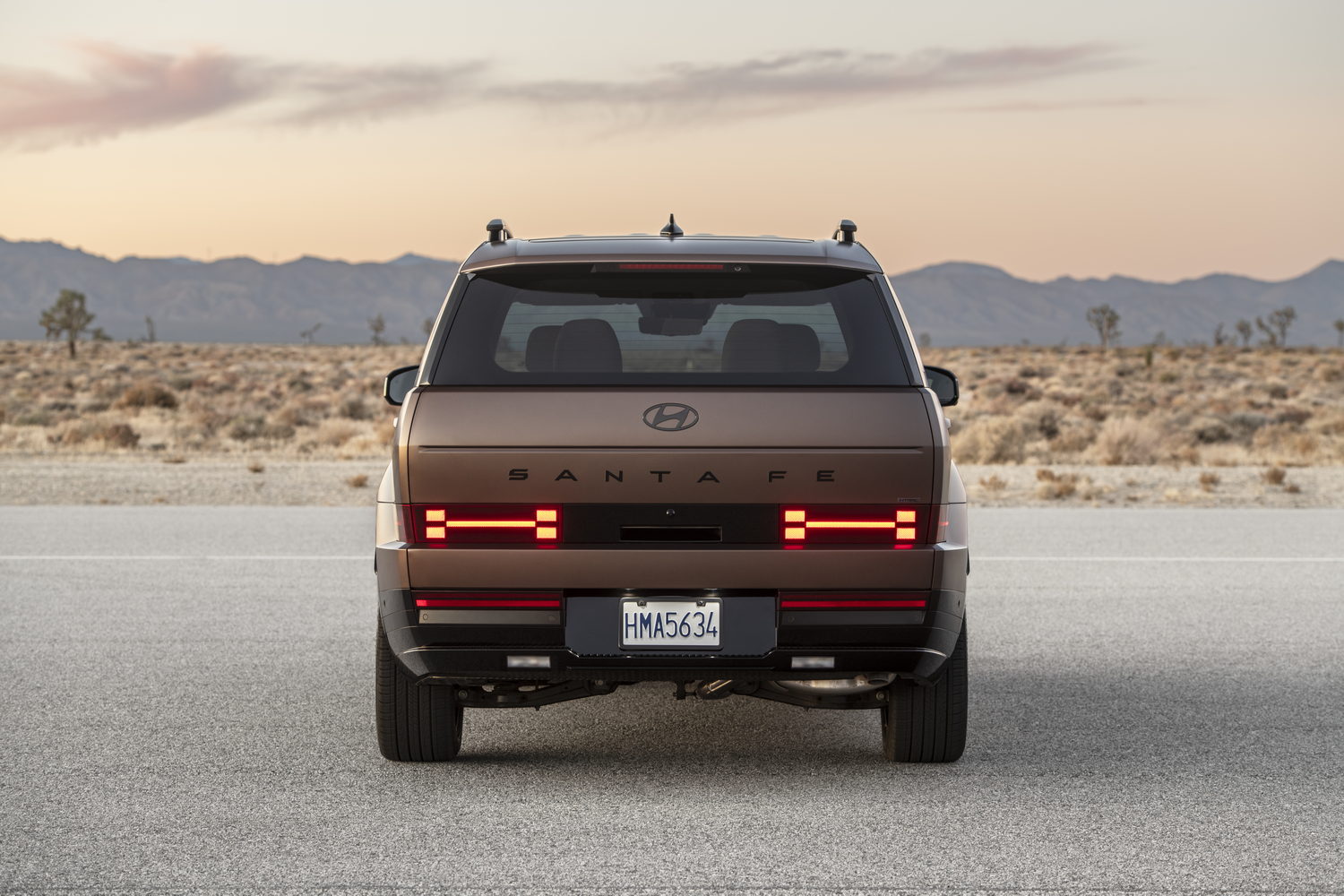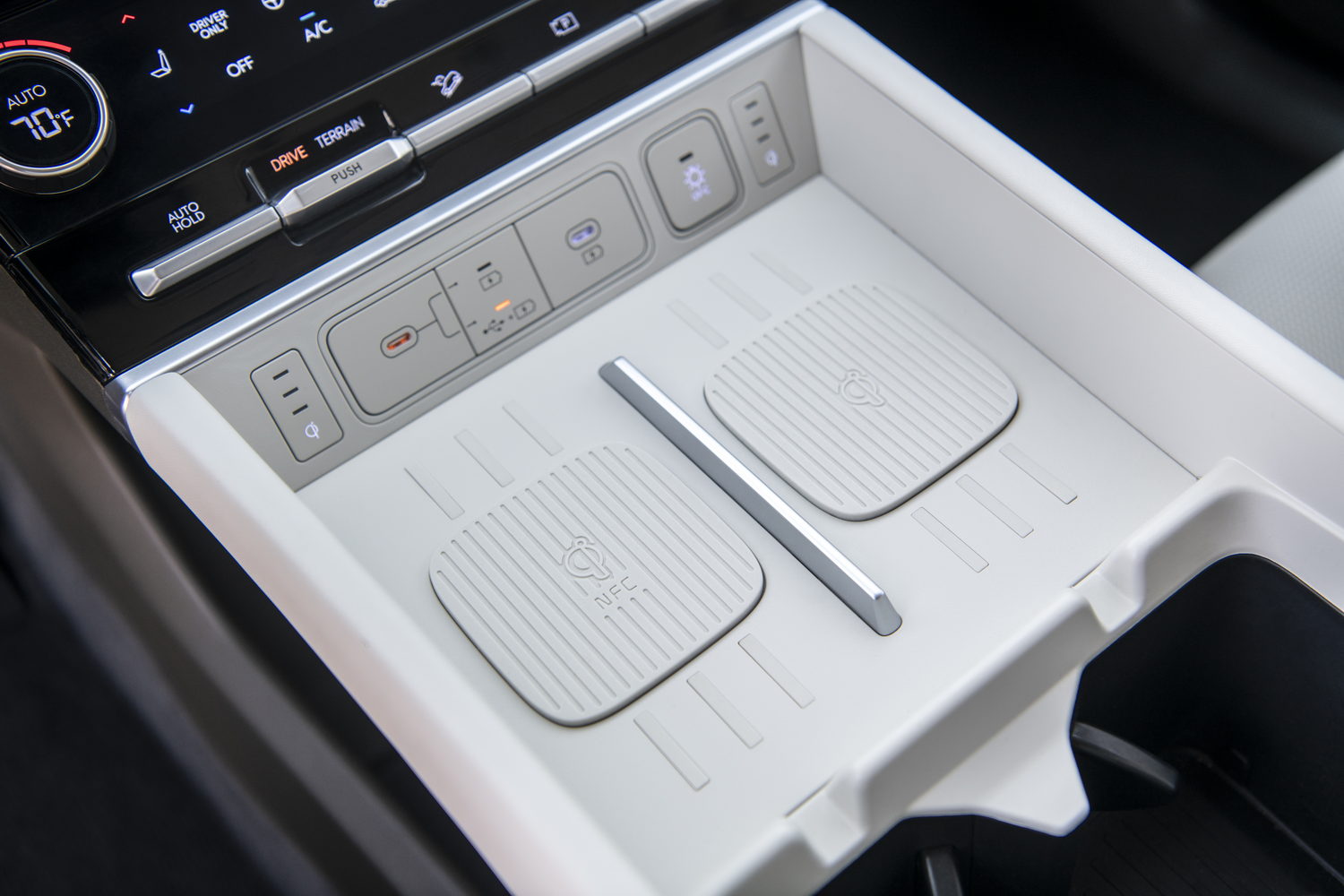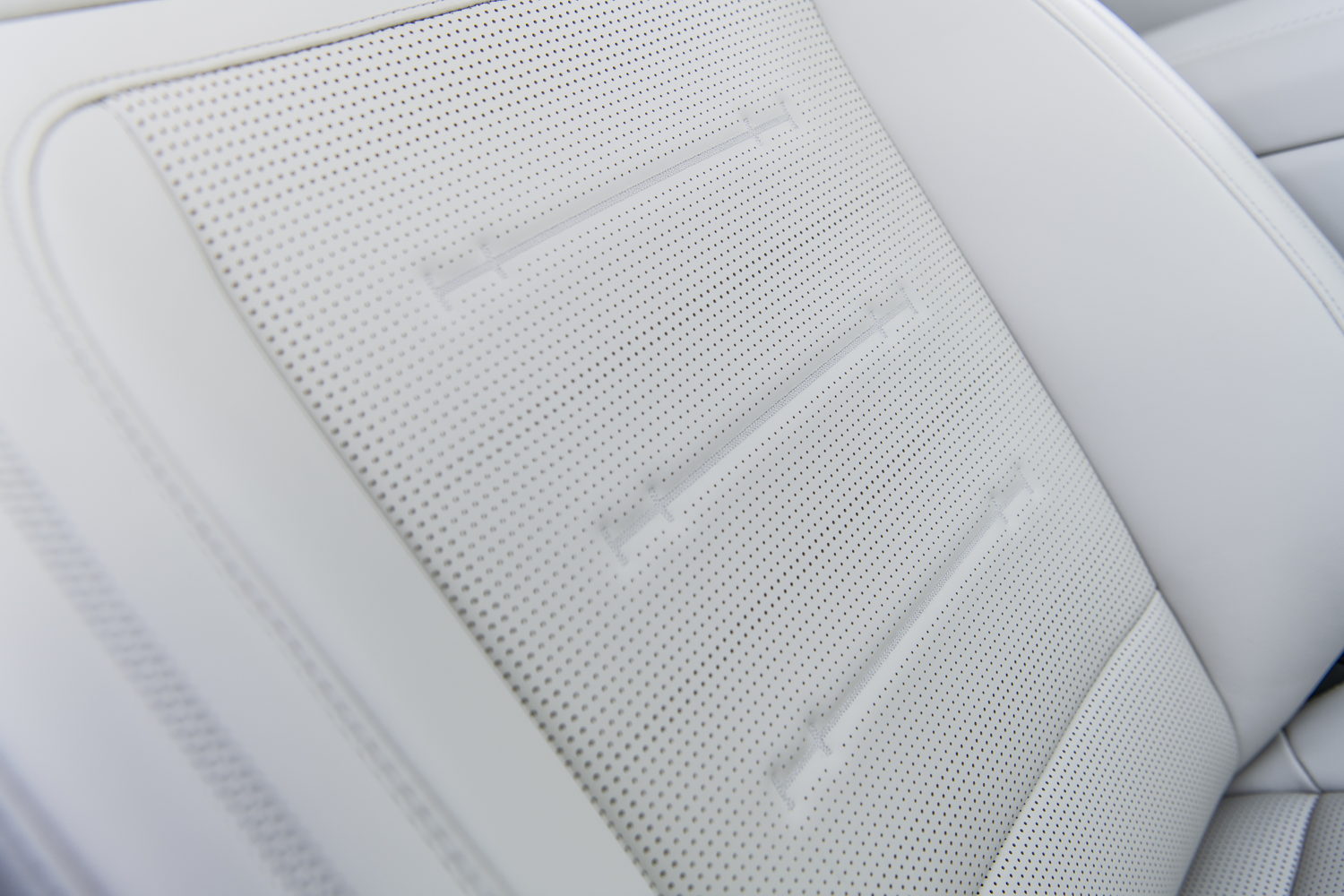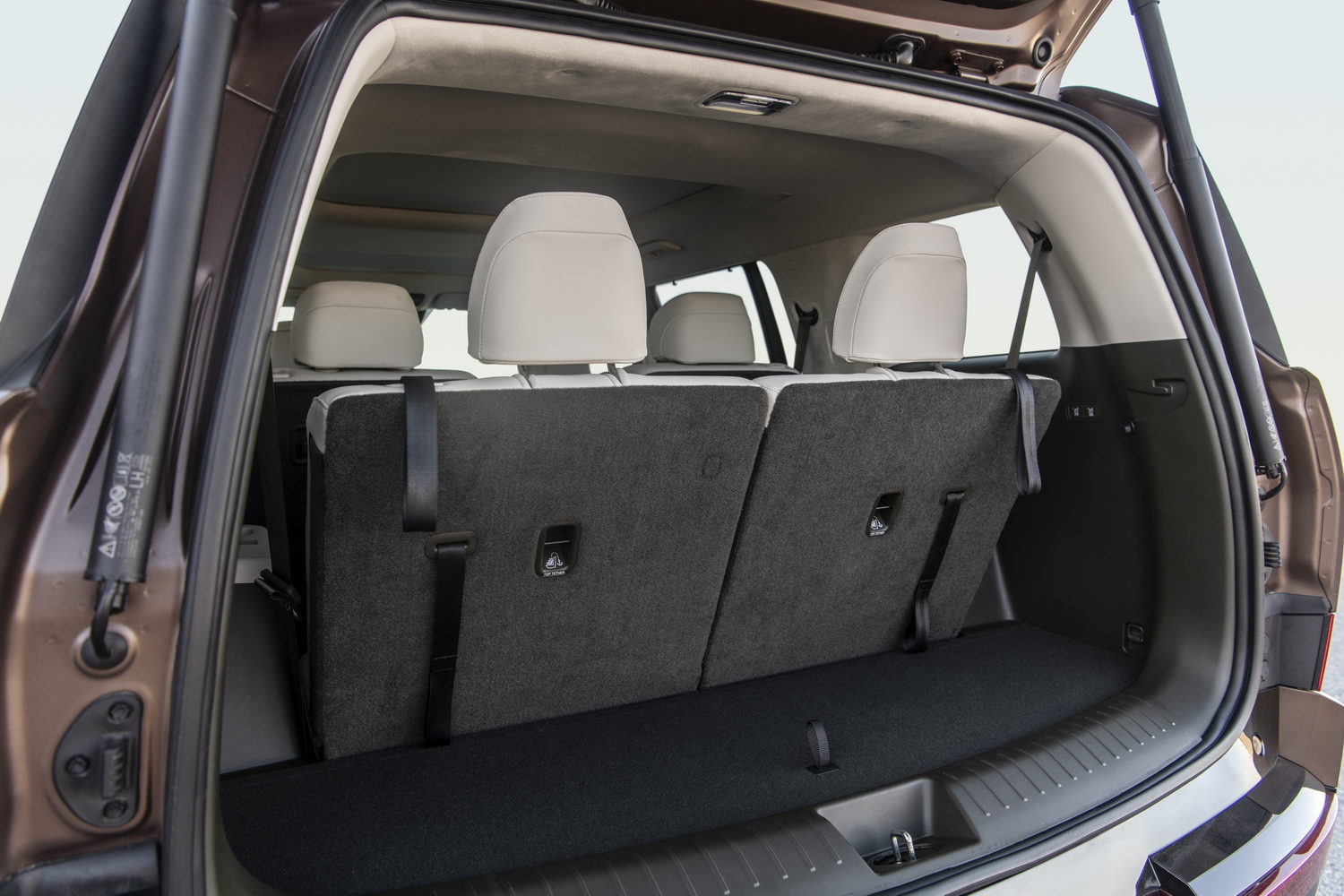The 2024 Hyundai Santa Fe SUV stands out thanks to its daring upright design, and there's a lot more going on under the skin. It's a larger and even more luxurious car than before with masses of space and a high-quality feel throughout. Hybrid power comes to the fore for this fifth generation of the Santa Fe and its development has been more focused on family motoring than ever before. Ahead of its launch in Ireland, we got the opportunity to test-drive a US-market pre-production prototype.
In the metal
Given the gentle evolution of the exterior styling of the Hyundai Santa Fe until now, the look of the new model may be a shock to some. It shouldn't be a surprise given Hyundai's recent form when it comes to design, as it gives its designers more free rein than most car makers are, but that still doesn't prepare you for the first time you see the new Santa Fe in person.
The overall aesthetic is squarer and chunkier than before to give the car a more utilitarian image, though the upright proportions pay dividends when it comes to interior space, too. And we're told that the new Santa Fe's design started with the requirements of rear-seat passengers and the desire to have the widest boot opening in the sector. In a bid for more room for those in the two back rows of seats, the wheelbase has been lengthened, while the wide opening has been achieved by mounting the back lights below the struts that hold the tailgate up.
This layout has resulted in the most divisive aspect of the car's styling with a big expanse of metal above notably low-set back lights. We're not massive fans of the look, though perhaps it will grow on us. We do love the pixelated lights themselves, which feature a neat H motif when lit. That's echoed in the front lights, which are also joined by a light bar. The square-jawed nose should hold more universal appeal to buyers.
Disguising the enlarged dimensions is unusual treatment of the wheelarches, mixing pronounced extensions of the wings - front and rear - with a gloss-black surround that links in with the side sills and lower bumper. We've seen an all-black version of the Santa Fe and without the contrasting lower section it looks a little heavy-handed and bulbous in comparison.
Whatever you think of the exterior, it's impossible not to be impressed by the Santa Fe's cabin. The focus on rear space has paid off as adults of up to six-foot tall can comfortably sit even in the rear-most row, while the middle row is particularly spacious. That'll be of use to parents with lots of young children too, of course, as bulky rear-facing child seats are required for longer than ever. There are ISOFIX points in the outer two seats in the middle row and in both seats in the rearmost row.
Although the Irish line-up has yet to be announced, we know that the Santa Fe will be made with three different seating layouts. The five-seat version has a massive boot of 725 litres, though it's expected that the seven-seat model will be the focus of the Irish market. There may also be a six-seat option with a pair of proper individual chairs for the second row, which really adds to the luxury vibe of the cabin. All rear seating can be folded to create one cavernous area with a flat floor, while there are air vents and USB ports throughout the back of the car, too.
Up front, the Santa Fe takes the latest generation of Hyundai's interior technology and mixes it with plenty of sustainable materials that also happen to feel of high quality. The result is a cabin that has taken a noticeable step up from the outgoing car's in terms of luxuriousness, while also amping up the practicality. There's a swish looking curved digital dashboard encompassing the 12.3-inch instrumentation display and central touchscreen, though this doesn't sit proud of a low fascia as in many cars today; instead, the square exterior style is mirrored in the upright surfaces, giving the cabin a solid and safe feel.
There's a full-width air vent feature helping to reduce the slab-sidedness of the layout, and on the passenger side a slender UV-C sterilisation compartment (it can sterilise baby bottles and anything else that fits in) sits above a large glovebox. The centre console is also well thought out. We're glad to see mostly-physical controls for the air conditioning and heating, while the movement of the drive selector to the steering column means there's space between the front seats for two wireless charging pads. They have a rubberised surface to hold devices in place and there are USB-C ports as well if required.
Behind all that is a pair of generously-sized cupholders and a large under-armrest storage box. Ingeniously, this is just as accessible from the rear of the car as it is from the front thanks to a clever double-hinge arrangement. Underneath is another large storage area. So yes, the Santa Fe's interior is more premium than ever, but it also appears to be designed around the needs of a busy family.
Driving it
I know what you're thinking: how can a 1.6-litre engine handle such a big car? Remarkably well as it turns out. While it's true that we haven't yet had the chance to fill the Santa Fe with seven people and their luggage or attempt to tow a trailer up a steep incline, we did test it with two on board on a variety of roads, including a fast-paced motorway and a fiendishly twisting mountain road. It's no sports car, but neither did it disgrace itself.
The engine under the bonnet is turbocharged of course, and when assisted by the electric motor it produces up to 235hp and 367Nm of torque. That's more than sufficient to push the car along with as much vim as you'd want in a family vehicle. It didn't feel wanting when the roads turned interesting and, more importantly, the engine doesn't have to spin at high speeds to maintain a quick cruising speed on the motorway. In fact, it's remarkably hushed.
That extends to the car as a whole. On a longer wheelbase than before, this new Santa Fe feels far more car-like than its predecessors. Not only that, but it does a seriously good impression of a luxury car, too, and that's without resorting to adaptive damping or air suspension. It really is an outstandingly comfortable car. And while it's possible that the chassis tune on our US-market prototype may differ a little from what's launched in Ireland next year, this vehicle handled the bends as well as it did the motorway cruising, so that bodes well for its capability on Irish roads, too.
What you get for your money
It has been confirmed that the new Hyundai Santa Fe will never feature a diesel engine. European buyers get the choice of two different hybrid systems with all-wheel drive - either the HEV variant tested here or a plug-in hybrid (PHEV) using the same base engine.
At the time of writing, there is no further information on Irish pricing or specifications for the new Hyundai Santa Fe. Due to a lower VRT rate, it's highly likely that the plug-in hybrid variant will be the most affordable. When Hyundai Ireland releases details, we will endeavour to update this section of the review.
Summary
First impressions at the wheel of a US-market example suggest that the 2024 Hyundai Santa Fe will be an even more useful and luxurious car than before. Its focus on practicality and space comes with a road-biased chassis that enhances the passenger experience no end, pairing with a hybrid-only offering and enhanced efficiency to ensure it moves with the times. If you're in the market for a large family car in 2024, make sure you check out the Santa Fe when it arrives.








































